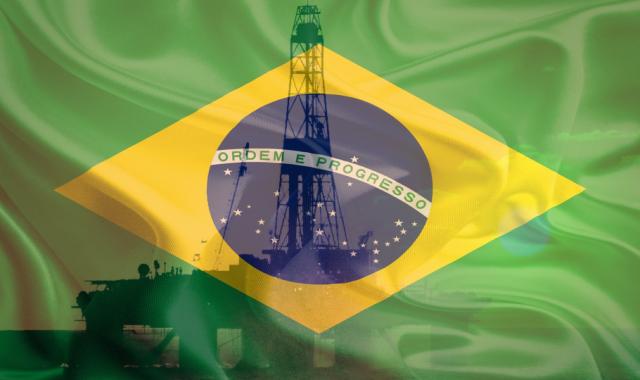
(Source: Shutterstock.com/Hart Energy)
Brazil’s presalt hydrocarbon riches have attracted some of the world’s biggest oil and gas players, but there are other areas offshore the country with potential.
The Sergipe Basin area is among these, according to Justin Smith, senior rigs market analyst for IHS Markit.
“Outside of the presalt, the Sergipe will probably be the most investment-heavy area in Brazil,” Smith said on a recent webinar. “How much exactly relative to the rest? It’s hard to say, but it’s a clear priority for both Petrobras and Exxon.”
The Brazilian state-owned company and Exxon Mobil Corp. are Brazil’s top largest acreage holders, and both have acreage in the Sergipe area offshore the country’s northeast region. Exxon Mobil added to its Sergipe-Alagoas Basin acreage in September, partnering with Murphy Oil Corp. and Brazil’s Enauta Energia to win exploration rights to three blocks in the basin. The consortium pledged to pay signing bonuses totaling about $1.9 million.
Brazil’s oil and gas industry is reemerging, after what could be described as a few rough years, having suffered from blows sustained by Petrobras’ deep debt, corruption and low earnings brought on by low oil prices.
The situation is turning around for the country and Petrobras. The company is selling off assets—including some interest in Sergipe-Alagoas Basin fields—to bring down debt as it continues to explore, develop and produce hydrocarbons, while the country’s regulators lure oil and gas companies to licensing rounds.
Brazil was the top area featured by Smith during a webinar focused on South America’s offshore sector.
RELATED: Exploration, Development Takes Shape Offshore South America
“I expect there to be quite a lot of interest there and it seems like it’ll probably be pretty positive in terms of results,” Smith said of Sergipe. “There have already been a few discoveries in the area so I expect there’ll be more in that region.”
The U.S. Geological Survey estimates the Sergipe-Alagoas Basin has nearly 2 billion barrels and about 4.4 trillion cubic feet of undiscovered oil and gas resources.
The basin spans about 60,500 sq km and is home to many petroleum systems, mainly in shallow water and the onshore part of the basin, according to Brazil’s oil regulator, ANP.
But discoveries of oil, gas and condensate in recent years have been made in the basin’s deepwater and ultra-deepwater. These have included six—Cumbe, Barra, Farfan, Muriú, Moita Bonita and Poço Verde—made by Petrobras. The company has said that roughly 20 million cubic meters per day of natural gas could be produced from the fields. It had plans for a long-term test in Sergipe’s Farfan area this year to improve characterization of the area’s reservoir rock and fluids.
RELATED: Petrobras Poised To Enter New Natural Gas Era Following Discoveries
Another area, outside presalt, getting attention is northeast Brazil’s Atlantic Margin.
“The downside to this area is that obtaining drilling permits and even seismic permits in this frontier region is a lengthy and occasionally unsuccessful process,” Smith said. “Operators are looking at roughly two years to get an environmental permit in these relatively unexplored pristine areas, although oil companies have been given extensions on the deadlines that come with their leases.”
As Smith explained, environmental concerns including proximity to biogenic reefs and concerns about a potential oil spill forced Total SA to abandon a project in the Foz do Amazonas Basin.
But potential drilling could take place east of Foz do Amazonas with Chariot Oil & Gas Ltd., Petrobras, Premier Oil Plc, Royal Dutch Shell Plc and Total looking to explore, he said.
Hope remains for the area, though licensing and logistical challenges have left the Atlantic Margin area untouched, according to Smith.
But presalt remains “the engine of Brazil’s future,” Smith said, noting Petrobras is investing “considerable sums of money and putting a number of rigs to work.”
Citing data from ANP, Smith said production from presalt fields has grown to more than 2.4 million barrels of oil equivalent per day, up from 41,000 boe/d in 2010.
“Arguably, the most impressive part about this is that all of the production is coming from just 110 wells,” Smith said.
Brazil’s next presalt auction, which will offer concessions in the 2,800-sq-km Transfer of Rights area off the country’s southeastern coast, is scheduled for Nov. 6. The auction was made possible after Petrobras and the government reached an agreement on a revised contract for the area.
RELATED: Transfer Of Rights Deal Opens Door For Brazil’s Biggest Presalt Auction Since Libra
ANP said the area could hold between 6 billion and 15 billion barrels (Bbbl) of oil in addition to the original 5 Bbbl granted to Petrobras, according to a Reuters report.
A court approved rules for the auction on Oct. 9.
“The result will generate thousands of new jobs, income and expected investments of over $ 1 trillion over the course of the contract,” Brazil’s Ministry of Mines and Energy said in a note. “With the approval of the Assignment Auction rules, Brazil is taking an important step towards becoming the world’s fifth-largest oil producer and doubling its current reserves to 30 billion barrels of oil equivalent.”
Recommended Reading
Seadrill Awarded $97.5 Million in Drillship Contracts
2024-01-30 - Seadrill will also resume management services for its West Auriga drillship earlier than anticipated.
TotalEnergies Starts Production at Akpo West Offshore Nigeria
2024-02-07 - Subsea tieback expected to add 14,000 bbl/d of condensate by mid-year, and up to 4 MMcm/d of gas by 2028.
Well Logging Could Get a Makeover
2024-02-27 - Aramco’s KASHF robot, expected to deploy in 2025, will be able to operate in both vertical and horizontal segments of wellbores.
Shell Brings Deepwater Rydberg Subsea Tieback Onstream
2024-02-23 - The two-well Gulf of Mexico development will send 16,000 boe/d at peak rates to the Appomattox production semisubmersible.
E&P Highlights: Feb. 26, 2024
2024-02-26 - Here’s a roundup of the latest E&P headlines, including interest in some projects changing hands and new contract awards.






